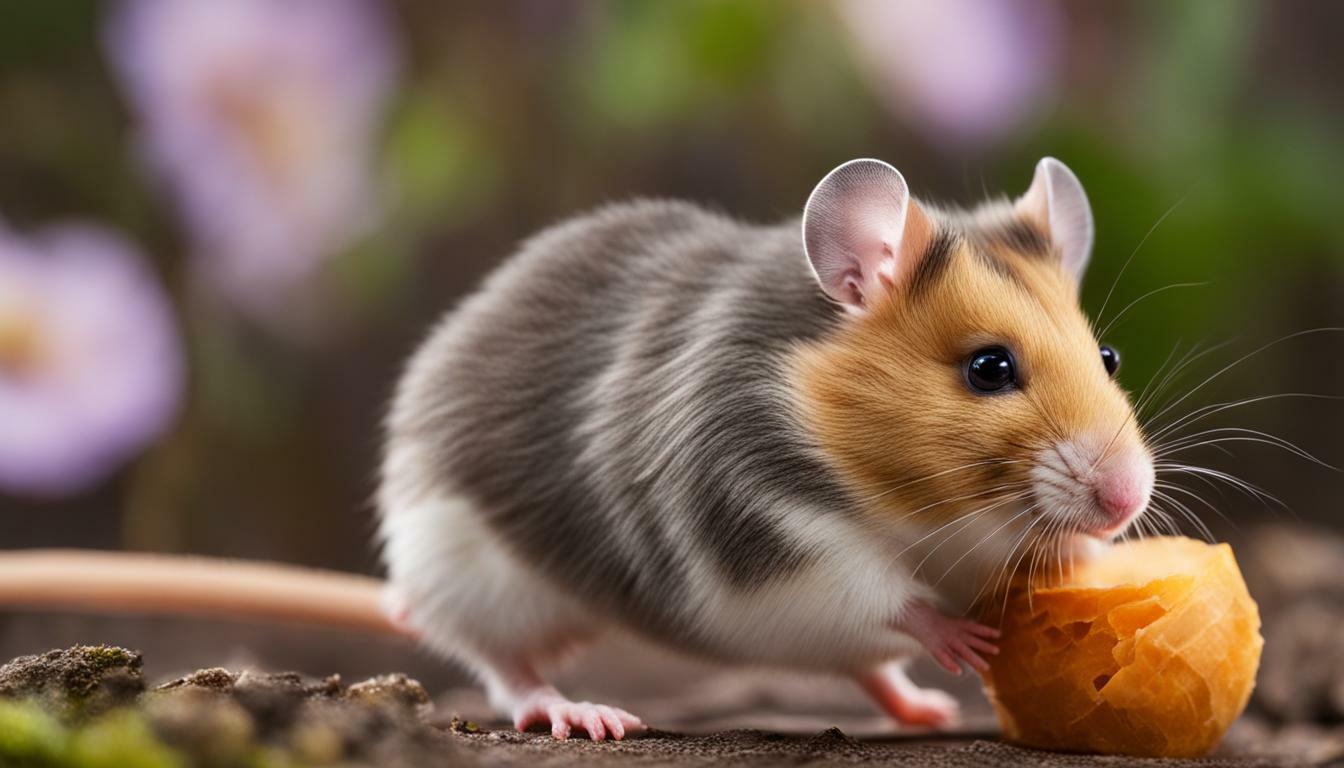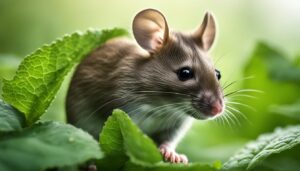Hamsters and rats both belong to the rodent family, but are they closely related? This is a question that many pet owners and rodent enthusiasts often wonder about. In this section, we will explore the relationship between hamsters and rats and provide you with a comprehensive comparison of these two popular pets.
- Hamsters and rats are both part of the rodent family, along with other popular pets like guinea pigs and mice.
- They share similar characteristics, such as living in burrows or hiding places.
- Hamsters and rats have some differences in appearance, size, personality, and lifestyle.
- Hamsters are known to be grumpy and prone to biting, while rats are more relaxed and less likely to bite.
- Rats are more intelligent and can be trained to learn tricks, while hamsters are generally more solitary and less interested in toys.
Similarities Between Hamsters and Rats
Despite their differences, hamsters and rats share several similarities in their physical traits and habits. Both rodents have fur-covered bodies, long tails, and sharp incisors that continually grow. These teeth are used for gnawing and chewing, helping them to explore their environment and maintain dental health.
Additionally, hamsters and rats are nocturnal creatures, meaning they are most active during the night. They have evolved to adapt to low-light conditions and have excellent senses of hearing and smell.
Another shared characteristic is their preference for burrowing and hiding. Hamsters and rats enjoy creating underground tunnels and nesting areas where they can feel safe and secure. This behavior is an instinctive response to their natural habitat, where they would seek protection from predators.
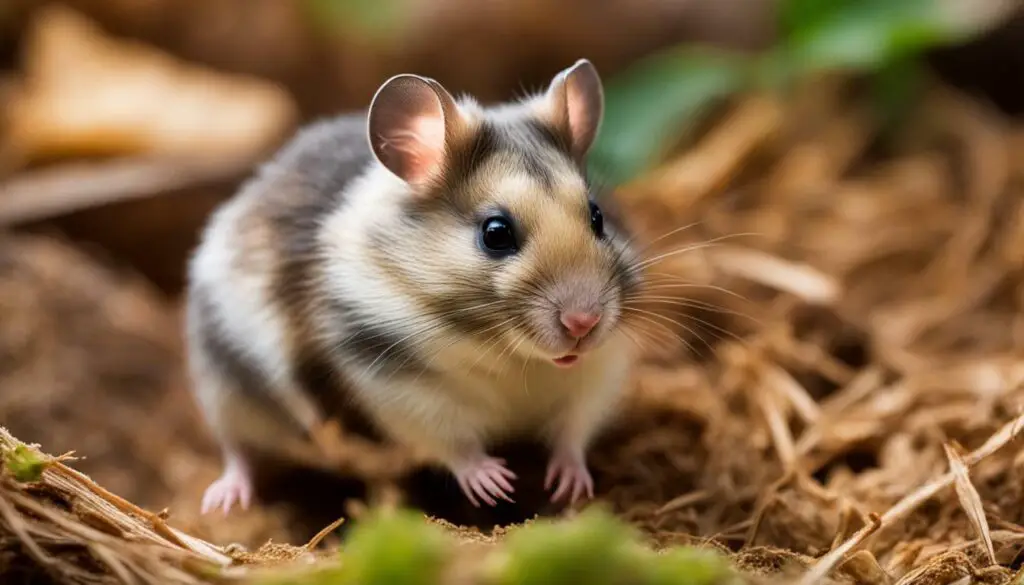
Differences Between Hamsters and Rats
While hamsters and rats have some similarities, they also have notable differences in their appearance, size, and species diversity. Hamsters come in several species, including the popular Syrian hamster, dwarf hamsters, and Roborovski hamsters. Each species has its own unique characteristics and care requirements. On the other hand, rats are more limited in terms of species diversity, with the most common pet rat being the fancy rat.
In terms of appearance, hamsters tend to have shorter tails and rounder bodies compared to rats. Hamsters also come in a variety of colors and patterns, making them visually appealing pets. Rats, on the other hand, have longer tails and slimmer bodies. Their fur can also vary in color and texture, but they generally have a sleeker appearance compared to hamsters.
When it comes to size, hamsters are typically smaller than rats. Syrian hamsters, the largest among the various hamster species, can reach lengths of up to 6 inches (15 cm) when fully grown. Dwarf hamsters are even smaller, usually measuring around 2 to 4 inches (5 to 10 cm) long. In contrast, adult fancy rats can grow up to 9 to 11 inches (23 to 28 cm) in length, making them larger than most hamsters.
| Hamsters | Rats |
|---|---|
| Syrian Hamster | Fancy Rat |
| Dwarf Hamsters | |
| Roborovski Hamsters |
“Hamsters tend to have shorter tails and rounder bodies compared to rats. Hamsters also come in a variety of colors and patterns, making them visually appealing pets.”
- Hamsters come in different species and have various care requirements.
- Rats are more limited in terms of species diversity, with the fancy rat being the most common pet rat.
- Hamsters have shorter tails and rounder bodies, while rats have longer tails and slimmer bodies.
- Hamsters are generally smaller than rats, with Syrian hamsters being the largest among the hamster species.
With their distinct appearances, sizes, and species diversity, choosing between a hamster and a rat as a pet ultimately depends on your personal preference and lifestyle. Whether you’re drawn to the adorable charm of hamsters or the sociable nature of rats, both animals can make rewarding and entertaining companions. Just remember to provide them with appropriate habitats, nutrition, and care to ensure their well-being.
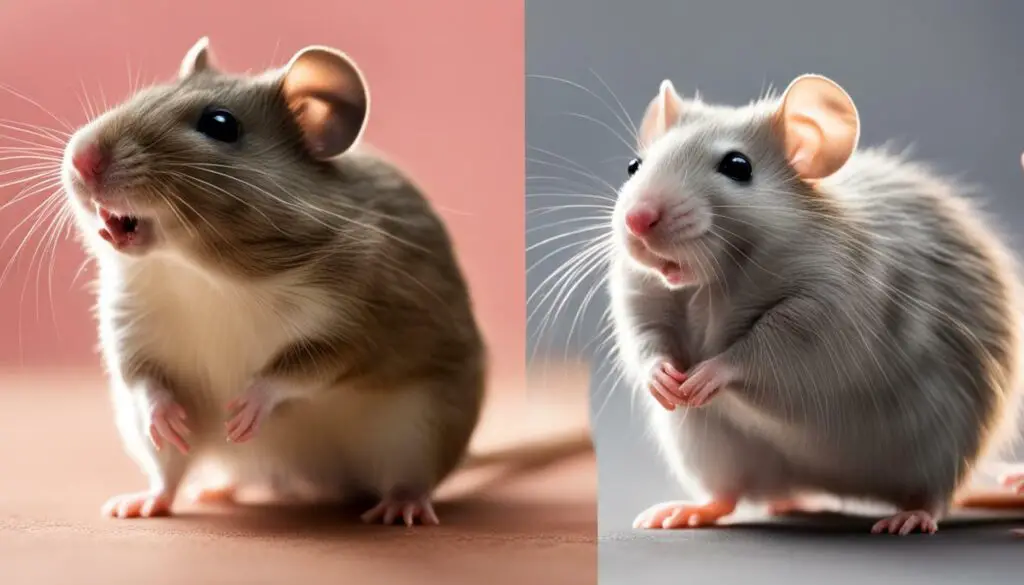
To understand the connection between hamsters and rats, let’s take a closer look at their evolutionary history and taxonomy. Both hamsters and rats belong to the rodent family, which includes various species of small mammals. Within the rodent family, hamsters and rats are categorized into different genera and species based on their distinct characteristics and genetic makeup.
Hamsters are classified under the subfamily Cricetinae, which consists of several genera including Mesocricetus, Phodopus, and Cricetulus. The most common pet hamsters, such as the Syrian and dwarf hamsters, belong to the genus Mesocricetus. On the other hand, rats come from the genus Rattus, with the most well-known pet rat being the Norway rat, also known as the brown rat.
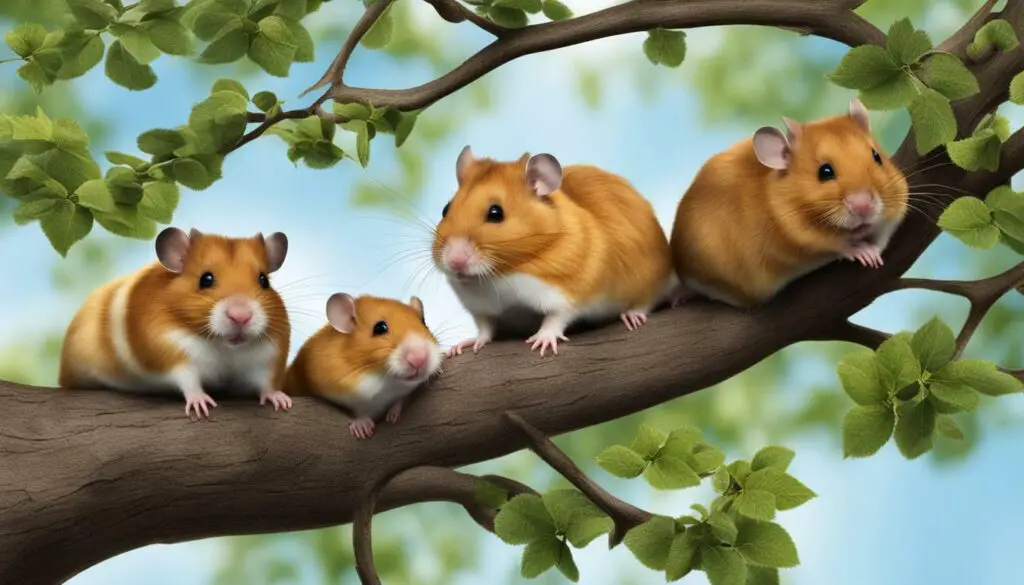
The evolutionary relationship between hamsters and rats can be visualized through their placement in the rodent family tree. While they share a common ancestor, hamsters and rats have diverged into separate branches over time, resulting in their distinct features and behaviors. This diversity within the rodent family highlights the wide variety of adaptations and survival strategies that have allowed these small mammals to thrive in different habitats around the world.
By examining the hamster and rat family tree, we gain insight into the shared ancestry and evolutionary paths of these fascinating creatures. Understanding their taxonomic classification helps us appreciate the rich diversity within the rodent family and allows us to make informed choices when it comes to selecting a pet that suits our preferences and lifestyles.
Hamsters: Solitary by Nature
Hamsters are known for their preference for solitude, and this characteristic sets them apart from rats and other social rodents. Unlike rats, which thrive in group settings, hamsters prefer to live alone in their own secluded space. This solitary nature is deeply ingrained in their behavior and is a crucial aspect to consider when deciding to own a hamster as a pet.
There are several reasons why hamsters exhibit this preference for solitude. In the wild, hamsters are burrowers, creating intricate underground tunnels and chambers to serve as their homes. These burrows provide them with security and a sense of ownership over their territory. In captivity, hamsters still retain this instinct, seeking out privacy and independence in their cages.
This solitary nature also extends to their interactions with humans. While hamsters can form a bond with their owners and enjoy brief periods of social interaction, they generally prefer to have their own space and time to themselves. This is important to keep in mind when handling or interacting with a hamster, as they may become stressed or agitated if they feel their personal boundaries are being invaded.

| Characteristics | Hamsters | Rats |
|---|---|---|
| Preferred Living Environment | Individual enclosures with hiding spaces | Group settings with social interaction |
| Behavior | Solitary, less likely to bite | Social, more relaxed |
| Intelligence | Lower intelligence compared to rats | Higher intelligence, capable of learning tricks |
| Training | Less responsive to training | Capable of being trained and learning tricks |
“Hamsters are intriguing creatures. Their preference for solitude and their ability to thrive on their own make them fascinating pets. Remember to respect their privacy and provide them with a safe and comfortable environment.”
The Solitary Life of Hamsters
Hamsters, being solitary by nature, require specific care and attention to ensure their well-being. Providing a spacious cage with hiding spots and tunnels allows them to create their own territory and feel secure. Additionally, providing ample mental and physical stimulation, such as toys and exercise wheels, can help prevent boredom and promote a healthy and happy hamster.
It is also essential to note that not all hamster species exhibit the same level of solitary behavior. Some species, such as Syrian hamsters, are particularly independent and prefer to live alone. Others, like dwarf hamsters, can coexist in pairs or small groups if introduced properly. Researching the specific needs and behavior of the hamster species you are considering can help you make an informed decision.
Remember, while hamsters may not be as social as rats or other rodents, they can still make fantastic pets with their unique personalities and adorable antics. By understanding and respecting their solitary nature, you can provide them with a fulfilling and enriching life as your companion.
Rats: Intelligent and Social
Rats are highly intelligent creatures and thrive in social settings, making them unique among rodent pets. Their intelligence has even been compared to that of dogs and cats. Rats have excellent memory and problem-solving skills, which allows them to learn and adapt quickly. Their social behavior is another notable trait, as they form strong bonds with their human caregivers and fellow rats. In fact, rats are often recommended to be kept in pairs or small groups to prevent loneliness and provide mental stimulation.
One fascinating aspect of rat intelligence is their ability to be trained. With patience and positive reinforcement, rats can learn a variety of tricks and commands. They can be taught to respond to their names, navigate mazes, and even perform agility courses. This intelligence and trainability make rats highly interactive and engaging pets.
Rats also display a unique sense of empathy and compassion towards their human companions. They can sense their owner’s emotions and provide comfort and support when needed. This emotional bond between rats and their owners often results in a deep and rewarding relationship.
Caring for Intelligent and Social Rats
Providing proper care for rats requires attention to their intellectual and social needs. Rats need a spacious cage with multiple levels and hiding spots to explore and play. They also benefit from regular mental stimulation, such as puzzle toys and interactive playtime with their owners.
Additionally, rats thrive when given opportunities for social interaction. This can include supervised playtime outside their cage, introducing them to new environments, and providing plenty of toys and activities to keep them mentally stimulated. It is important to remember that rats are highly social animals and should not be kept alone for prolonged periods.
Overall, rats make wonderful pets for those seeking intelligent, affectionate, and interactive companions. Their unique combination of intelligence, social behavior, and loyalty sets them apart from other rodent pets. If you are looking for a pet that can provide endless entertainment, companionship, and a bond that goes beyond expectations, a rat may be the perfect choice for you.
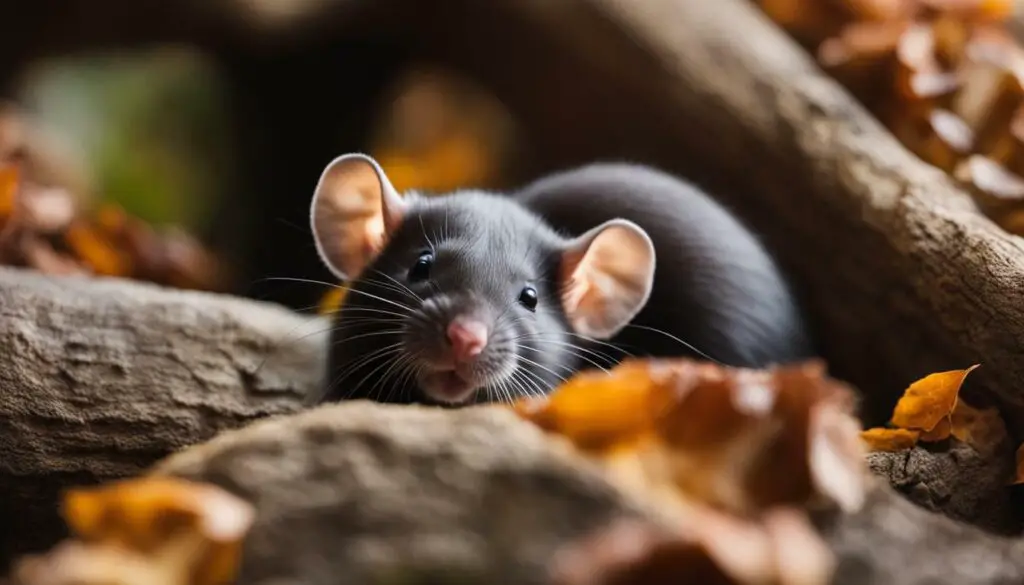
| Rats | Hamsters |
|---|---|
| Highly intelligent | Less intelligent |
| Social animals | Solitary creatures |
| Can be trained to learn tricks | Less interested in toys |
| Form strong bonds with humans | Less likely to bond closely with humans |
Hamsters: Grumpy or Playful?
Hamsters are known to have individualistic personalities, with some being more grumpy and prone to biting than others. While some hamsters may be playful and enjoy interacting with their owners, others may prefer to be left alone. It’s important to remember that each hamster is unique and may exhibit different behaviors based on their species and individual temperament.
When considering a hamster as a pet, it’s essential to understand their biting tendency. Hamsters have strong jaws and may bite if they feel threatened or scared. This behavior is a natural defense mechanism, and it can be challenging to predict which hamsters are more likely to bite. Therefore, it’s crucial to handle hamsters gently and provide them with a calm and stress-free environment to minimize the risk of biting incidents.
“Hamsters have a reputation for being grumpy, but it’s important to remember that their behavior can vary greatly. Some hamsters may be more sociable and enjoy interaction, while others are more independent and prefer to be left alone.”
It’s also worth noting that certain factors can influence a hamster’s temperament, such as their age and level of socialization. Younger hamsters may be more curious and prone to playfulness, while older hamsters may be more set in their ways and less inclined to interact. Providing plenty of enrichment activities, such as chew toys and exercise wheels, can help keep hamsters mentally stimulated and prevent them from becoming bored or irritable.
Ensuring the wellbeing of pet hamsters requires understanding and respecting their individual personality traits. While some hamsters may be grumpy by nature, others can be playful and enjoyable companions. By providing a suitable and nurturing environment, hamster owners can help their furry friends live happy and fulfilling lives.
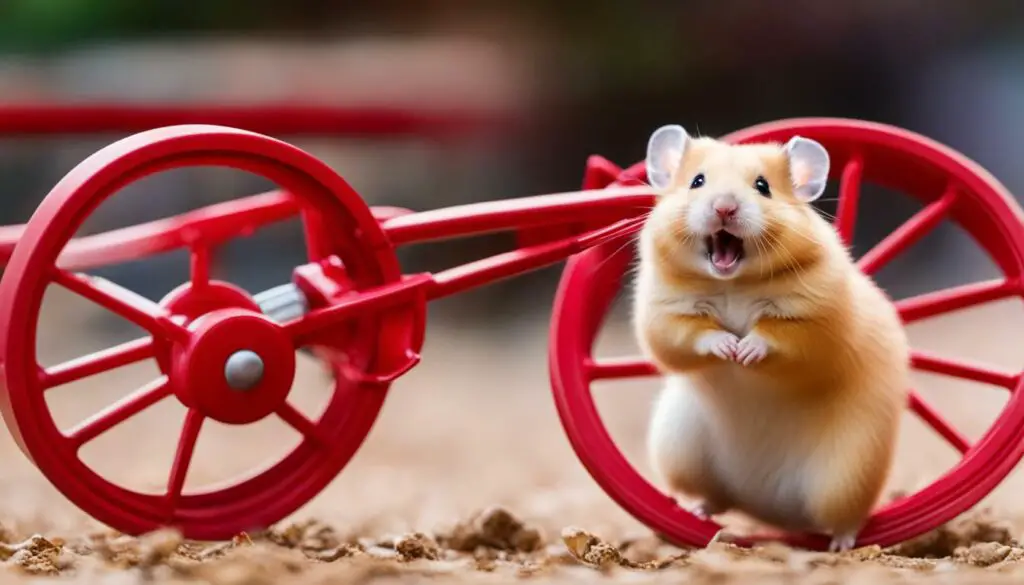
| Hamster Personality | Biting Tendency |
|---|---|
| Individualistic | Prone to biting if threatened or scared |
| Varies between hamsters | Cannot predict biting behavior accurately |
| Socialization and age impact temperament | Ensure gentle handling and a stress-free environment |
Rats: Docile and Trainable
Rats are generally docile and less likely to bite, making them more suitable for interactive play and training. Their friendly and social nature allows for a greater level of interaction with their owners compared to hamsters. Rats are known for their intelligence and ability to learn tricks, making them a popular choice among pet owners seeking a more interactive and trainable pet.
With proper handling and socialization, rats can form strong bonds with their owners. They enjoy being held and can be trained to respond to commands and cues. Rats are curious animals and thrive in an enriched environment with plenty of toys and activities to keep them mentally stimulated. They can be taught various tricks, such as coming when called, spinning in circles, or even navigating through obstacle courses.
Training rats not only provides mental stimulation for them but also strengthens the bond between owner and pet. It is important to remember that positive reinforcement techniques should always be used when training rats, as they respond well to rewards and affection. Patience and consistency are key when working with these intelligent creatures, and their playful and eager-to-learn nature makes training a rewarding experience for both the owner and the rat.
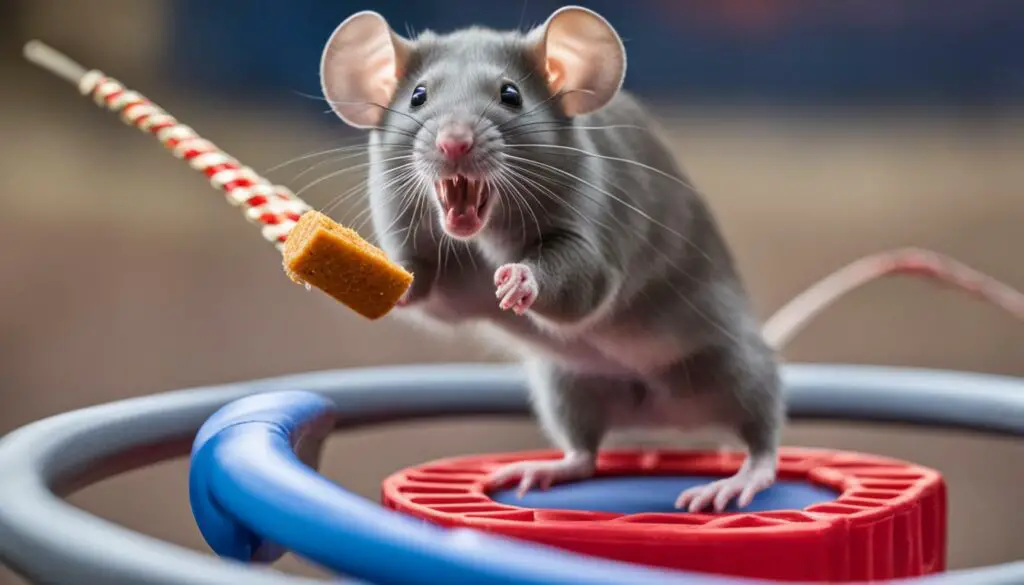
- Start training your rat in a quiet and distraction-free environment.
- Use small, bite-sized treats as rewards during training sessions.
- Break down complex tricks into smaller, manageable steps.
- Be consistent with your training schedule and practice sessions.
- Keep training sessions short and engaging to maintain your rat’s interest.
- Praise and reward your rat immediately after they successfully perform a trick.
- Use clicker training or a verbal cue to associate specific behaviors with rewards.
By providing a stimulating environment, offering positive reinforcement, and investing time and effort into training, you can unlock the full potential of your rat’s intelligence and create a strong bond based on trust and companionship.
| Advantages of Rats as Pets | Disadvantages of Rats as Pets |
|---|---|
| Rats are highly intelligent and trainable. | Rats have a relatively short lifespan compared to some other pets. |
| Rats are social animals that enjoy human interactions. | Rats require a larger cage with plenty of space for exercise. |
| Rats are less likely to bite compared to some other small animals. | Rats are prone to health issues such as respiratory infections. |
Choosing Between a Hamster and a Rat
Deciding whether to adopt a hamster or a rat as a pet comes down to personal preference and understanding their unique characteristics. Both hamsters and rats make great companions, but they have distinct differences that may sway your decision.
When it comes to size, hamsters are generally smaller, making them a great choice for those with limited space. They are also more solitary animals, preferring to have their own territory. Rats, on the other hand, are larger and more social creatures. They thrive on companionship and enjoy interacting with their human caregivers.
If you’re looking for a pet that can be easily trained and enjoys learning tricks, rats are the way to go. They are highly intelligent and can be taught a variety of behaviors. Hamsters, on the other hand, are less interested in toys and training. They are more content with exploring their environment and nesting in their cozy bedding.
One important factor to consider is that hamsters have a reputation for being grumpy and can be prone to biting. While not all hamsters exhibit this behavior, it’s something to keep in mind if you have young children or other pets at home. Rats, on the other hand, are generally more docile and less likely to bite.
Ultimately, the choice between a hamster and a rat as a pet comes down to your personal preferences and lifestyle. If you’re someone who enjoys a more laid-back and social pet, a rat may be the perfect fit for you. If you prefer a smaller, low-maintenance pet that enjoys some independence, a hamster may be more suitable. Take the time to research both options and spend time with each animal before making your decision. Remember, whichever pet you choose, they will bring joy and companionship into your life.
Hamster vs. Rat Comparison
| Hamsters | Rats | |
|---|---|---|
| Size | Smaller | Larger |
| Nature | Solitary | Social |
| Intelligence | Less trainable | Highly trainable |
| Behavior | Can be grumpy and prone to biting | Generally docile and less likely to bite |
| Space Requirement | Smaller cages | Larger cages |
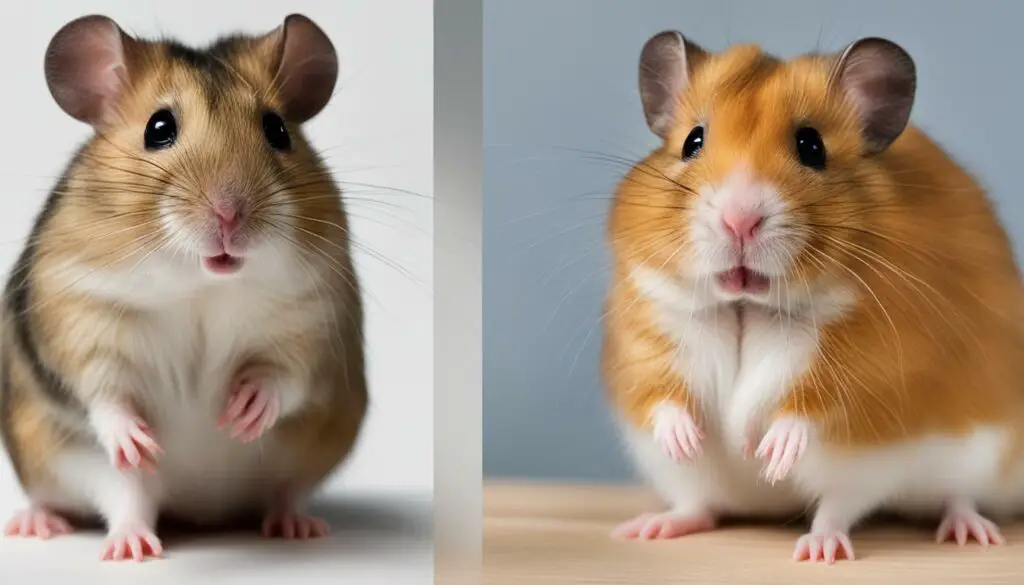
Owning a hamster or a rat requires understanding their specific needs, from proper housing and care to their lifespan and breeding habits. While both hamsters and rats make delightful pets, there are some key differences to consider before making your choice.
Hamster Species: There are several species of hamsters commonly kept as pets, including Syrian hamsters, dwarf hamsters, and Roborovski hamsters. Each species has its own unique characteristics and care requirements. Syrian hamsters, for example, are larger and more solitary, while dwarf hamsters are smaller and can be kept in pairs or groups. Roborovski hamsters are known for their energetic nature and need plenty of exercise.
Rat Species: When it comes to rats, the most popular pet species are the fancy rats, which are bred specifically for companionship. Fancy rats come in a variety of colors and coat types, making them visually appealing pets. Unlike hamsters, fancy rats are highly social animals and thrive when kept in pairs or small groups. They enjoy interaction with their owners and can form strong bonds.
Proper Housing and Care: Both hamsters and rats require appropriate housing to ensure their well-being. Hamsters need spacious cages with solid flooring, as they are excellent burrowers. Providing them with hiding places, tunnels, and toys will stimulate their natural behaviors. Rats, on the other hand, require multi-level cages with ramps and plenty of space for climbing and exploration. They also benefit from mental stimulation, so providing them with toys, puzzles, and social interaction is important.
Lifespan and Breeding Habits: Hamsters typically have shorter lifespans compared to rats, with an average of around 2 to 3 years. Rats, on the other hand, can live for 2 to 4 years or even longer with proper care. It’s important to note that both hamsters and rats have prolific breeding abilities, so if you don’t want to end up with a surprise litter, it’s best to keep them as single-sex pairs or groups.
Choosing the Right Pet
In summary, owning a hamster or a rat can bring joy and companionship into your life. Hamsters are ideal for those who prefer a more independent pet that requires less social interaction. They are generally low maintenance and can thrive in a smaller living space. Rats, on the other hand, are highly sociable and intelligent creatures that thrive on human companionship. They enjoy being handled and can be trained to perform tricks.
| Hamsters | Rats |
|---|---|
| Solitary nature | Highly social animals |
| Shorter lifespan (2-3 years) | Longer lifespan (2-4 years) |
| Less prone to biting | More relaxed and less likely to bite |
| Less trainable | Highly trainable |
Ultimately, the choice between a hamster and a rat as a pet depends on your personal preferences, available space, and ability to provide the necessary care and attention. Whichever pet you choose, be sure to research their specific needs and provide them with a loving and enriching environment to ensure their well-being.
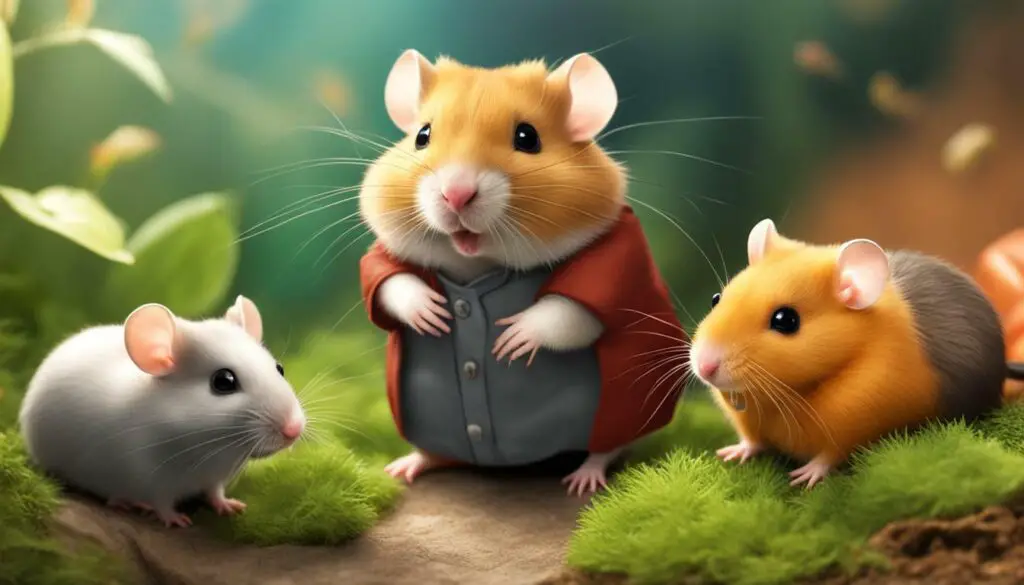
There are several misconceptions surrounding hamsters and rats that often lead to misunderstandings about their nature and behavior. Let’s take a closer look at some of the most common misconceptions:
- Hamsters are dirty and carry diseases: While it is true that rodents, including hamsters, can carry diseases, proper care and hygiene can minimize the risks. Regular cleaning of their cages, providing fresh bedding, and providing a clean water source can help maintain a healthy environment for your hamster. It is also important to note that with proper handling and care, the chances of contracting a disease from a pet hamster are extremely low.
- Rats are aggressive and dangerous: Despite their reputation, not all rats are aggressive or dangerous. Domesticated rats, often kept as pets, are usually friendly and can even form strong bonds with their owners. These rats have been selectively bred for generations to have calm and docile temperaments. It is important to spend time socializing and training your pet rat to ensure they are comfortable and well-behaved.
- Hamsters and rats are only suitable for children: While hamsters and rats can make great pets for children, they are not exclusively children’s pets. Many adults find joy in owning and caring for these small creatures. They can be a source of companionship and entertainment for people of all ages. It is important to consider the individual’s lifestyle, commitment, and ability to provide proper care before bringing a hamster or rat into your home.
In conclusion, it is crucial to separate fact from fiction when it comes to hamsters and rats. They are fascinating animals with unique characteristics and behaviors. By dispelling these common misconceptions, we can better understand and appreciate these delightful creatures as pets. Remember, always do your research and consult with professionals to ensure you are providing the best care for your furry friend.
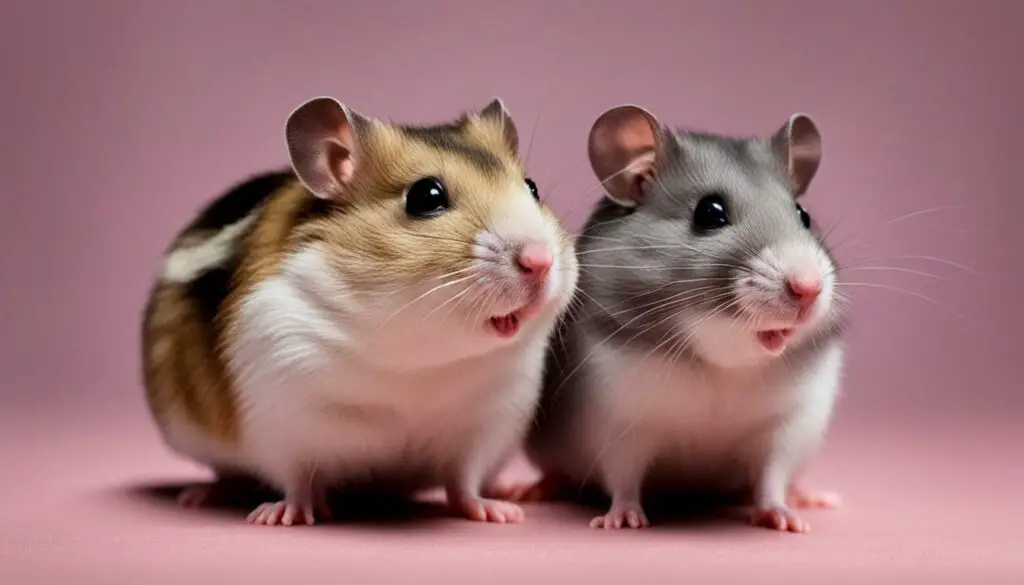
Conclusion
In conclusion, while hamsters and rats share a common ancestry as part of the rodent family, they have distinct characteristics and behaviors that make them unique pets suited to different preferences and lifestyles.
Hamsters, known for their adorable appearance and small size, are solitary creatures by nature. They prefer to live alone and are most active during the night. Though they may have a reputation for being grumpy and occasionally biting, they can still form a bond with their owners through gentle handling and patient interaction.
Rats, on the other hand, are highly intelligent and social animals. They thrive in groups and enjoy the company of their human caregivers. Unlike hamsters, rats can be trained to learn tricks and are less likely to exhibit grumpy behavior. They are also more active during the day, making them an engaging pet for owners who have more time for social interaction.
When deciding between a hamster and a rat as a pet, it’s essential to consider your own lifestyle and preferences. If you prefer a low-maintenance pet that requires less social interaction and a quieter environment, a hamster may be the right choice for you. However, if you’re looking for a highly interactive and trainable pet that enjoys socializing with its owner, a rat could be the perfect companion.
FAQ
Are hamsters related to rats?
Yes, hamsters are indeed rodents and are related to rats. Both hamsters and rats are part of the rodent family, along with other popular pets such as gerbils, guinea pigs, mice, and rats.
What are the similarities between hamsters and rats?
Hamsters and rats share similar characteristics and behaviors, such as living in burrows or other hiding places. They both belong to the rodent family and have a similar lifestyle.
What are the differences between hamsters and rats?
Hamsters and rats have some differences in their appearance, size, personality, and lifestyle. For example, hamsters are known to be grumpy and can be prone to biting, while rats are more relaxed and less likely to bite. Rats are also more intelligent and can be trained to learn tricks, whereas hamsters are less bothered by toys and are generally more solitary.
Where do hamsters and rats fit in the rodent family tree?
Hamsters and rats are part of the rodent family and share a common ancestry. They are both members of the subfamily Murinae, which also includes other species of mice and rats.
Are hamsters solitary by nature?
Yes, hamsters are solitary animals by nature. They prefer to live alone and may become stressed or aggressive if forced to share their space with other hamsters.
Are rats intelligent and social?
Yes, rats are known for their intelligence and social nature. They can be trained to learn tricks and enjoy socializing with both humans and other rats.
Are hamsters grumpy or playful?
Hamsters have a reputation for being grumpy and may exhibit occasional biting behavior. However, they can also be playful and enjoy interacting with their environment.
Can rats be trained?
Yes, rats are highly trainable and can learn a variety of tricks. They are intelligent animals and enjoy mental stimulation.
How do I choose between a hamster and a rat as a pet?
The choice between a hamster and a rat as a pet depends on your personal preference and lifestyle. Consider factors such as the level of interaction you desire, the amount of space and time you can dedicate to your pet, and your preferences for temperament and behavior.
What should I know about owning a hamster or a rat?
Owning a hamster or a rat requires providing them with appropriate housing, food, and care. They have specific dietary and environmental needs that should be met to ensure their well-being.
What are some common misconceptions about hamsters and rats?
Some common misconceptions about hamsters and rats include the belief that they are dirty or carry diseases. In reality, with proper care and hygiene, both hamsters and rats can be clean and healthy pets.

